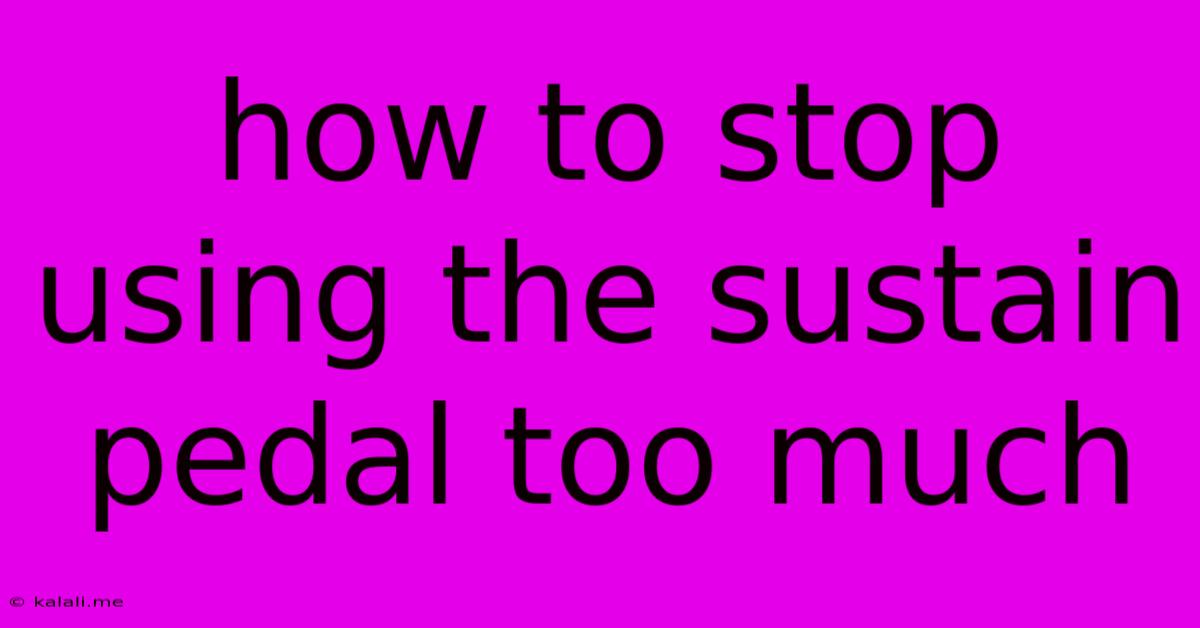How To Stop Using The Sustain Pedal Too Much
Kalali
Jun 03, 2025 · 3 min read

Table of Contents
How to Stop Overusing the Sustain Pedal: Mastering Piano Dynamics and Expression
Many pianists, especially beginners, fall into the trap of relying too heavily on the sustain pedal. While the pedal is a powerful tool for creating rich soundscapes and legato lines, overusing it can muddle the texture of your playing, obscuring clarity and dynamics. This article will guide you on how to refine your pedal technique and unlock a more nuanced and expressive performance. Learning to use the sustain pedal effectively will significantly enhance your musicality.
Understanding the Purpose of the Sustain Pedal
The primary function of the sustain pedal isn't to simply make notes last longer. It's to create connections between notes, enhance resonance, and add depth to your playing. Think of it as a subtle shaper of tone and texture, not a volume knob. Overusing it leads to a blurry, indistinct sound, masking the individual notes and melodic lines.
Common Mistakes and How to Avoid Them
Here are some common pitfalls pianists make with the sustain pedal, and how to address them:
-
Holding the pedal down for extended periods: This is the most common mistake. Instead of holding the pedal down constantly, practice releasing it precisely after each chord or phrase. Listen attentively to how the notes decay naturally. This allows for a clearer articulation of each musical idea.
-
Using the pedal to compensate for poor technique: If your playing lacks clarity or precision, the sustain pedal won't magically fix it. Focus on improving your finger technique, ensuring clean articulation and even voicing. Proper fingering and hand position are crucial for clear musical phrasing.
-
Ignoring the harmonic implications: The sustain pedal affects the harmonic content of the music. Improper usage can create unwanted resonances or clashing harmonies. Pay close attention to the harmonic structure of the piece and use the pedal strategically to enhance, not obscure, the harmony.
-
Lack of Variation: Using the pedal consistently with the same pressure creates a monotonous sound. Experiment with different levels of pedal pressure to achieve a wider range of tonal colors. This will make your playing far more interesting and engaging.
Developing Good Pedal Technique:
Here's a step-by-step approach to improving your sustain pedal technique:
-
Practice without the pedal: Begin by playing pieces without using the pedal at all. This helps you develop a strong sense of articulation and rhythm. Pay attention to the natural decay of the notes.
-
Introduce the pedal gradually: Start by using the pedal sparingly, focusing on connecting only a few notes at a time. Experiment with the timing and pressure, listening carefully to the resulting sound.
-
Listen critically: Record yourself playing and listen back critically. This will help you identify areas where you overuse the pedal or where it could be used more effectively.
-
Focus on articulation: Practice playing scales and arpeggios with precise articulation, using the pedal only to create subtle connections between notes.
-
Experiment with half-pedaling: This involves pressing the pedal down partially, creating a more delicate and controlled resonance. This advanced technique adds another layer of expressive control.
Advanced Techniques:
-
Selective Pedaling: Carefully choose which notes or chords benefit from sustaining. Consider the harmonic context and the overall musical effect.
-
Pedal Changes: Practice smooth, gradual changes in pedal pressure, creating subtle shifts in tone and resonance. Avoid abrupt pedal changes which can sound jarring.
-
Using the Pedal for "Color": Don't be afraid to experiment with the sustain pedal to create unique tonal colors. For example, use it to slightly soften the attack of certain notes, creating a more ethereal effect.
By following these tips and practicing diligently, you'll develop a more sophisticated and nuanced approach to using the sustain pedal. You'll discover how to use this powerful tool to enhance your musical expression without sacrificing clarity and precision. Remember, the goal is not to eliminate pedal use entirely, but to master its use for a more refined and expressive performance.
Latest Posts
Latest Posts
-
How Many Spells Can A Cleric Know At Level 5
Jun 05, 2025
-
Best Car For Hill Climb Racing
Jun 05, 2025
-
Use Wrist Unconsciously When Play Tennis
Jun 05, 2025
-
Breath Of The Wild Spicy Pepper Recipe
Jun 05, 2025
-
Jesus Curses The Fig Tree Luke
Jun 05, 2025
Related Post
Thank you for visiting our website which covers about How To Stop Using The Sustain Pedal Too Much . We hope the information provided has been useful to you. Feel free to contact us if you have any questions or need further assistance. See you next time and don't miss to bookmark.